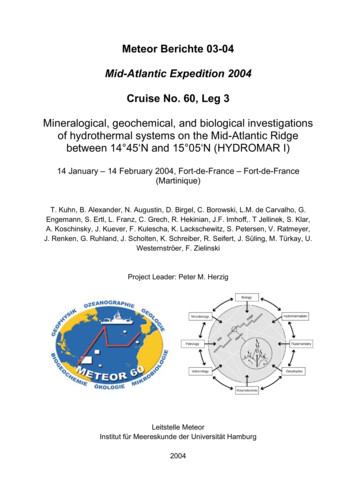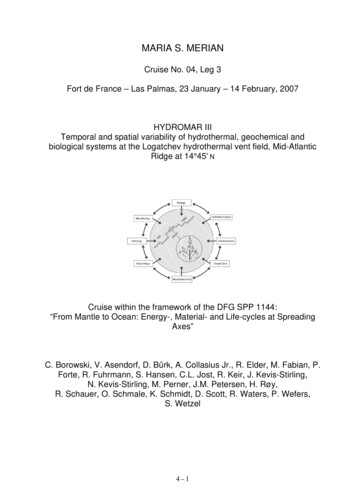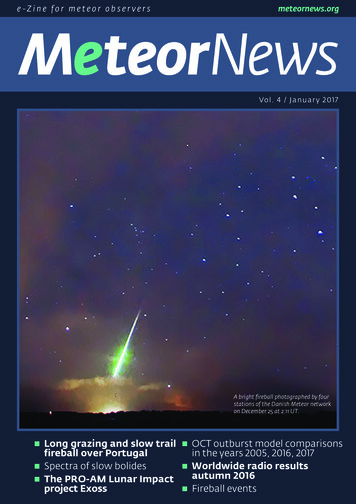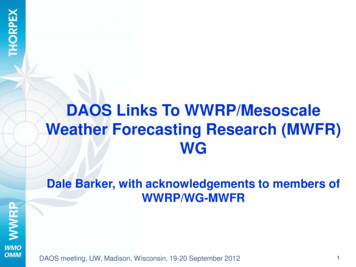
Transcription
Meteor Berichte 03-04Mid-Atlantic Expedition 2004Cruise No. 60, Leg 3Mineralogical, geochemical, and biological investigationsof hydrothermal systems on the Mid-Atlantic Ridgebetween 14 45‘N and 15 05‘N (HYDROMAR I)14 January – 14 February 2004, Fort-de-France – Fort-de-France(Martinique)T. Kuhn, B. Alexander, N. Augustin, D. Birgel, C. Borowski, L.M. de Carvalho, G.Engemann, S. Ertl, L. Franz, C. Grech, R. Hekinian, J.F. Imhoff,. T Jellinek, S. Klar,A. Koschinsky, J. Kuever, F. Kulescha, K. Lackschewitz, S. Petersen, V. Ratmeyer,J. Renken, G. Ruhland, J. Scholten, K. Schreiber, R. Seifert, J. Süling, M. Türkay, U.Westernströer, F. ZielinskiProject Leader: Peter M. HerzigLeitstelle MeteorInstitut für Meereskunde der Universität Hamburg2004
ContentSummary. 13.1 Participants. 33.2 Research Program. 53.3 Narrative of the Cruise . 53.4 Preliminary Results. 123.4.1 Seafloor mapping and structural geology123.4.1.1 Introduction123.4.1.2 Rift valley133.4.1.3 Rift mountains133.4.1.4 Off-axis volcanoes153.4.1.5 Slumped structures153.4.1.6 The formation of the Logatchev hydrothermal field163.4.2 Geology and morphology of the Logatchev-1 hydrothermal field163.4.3 ROV deployments203.4.4 Low-temperature measurements in the Logatchev-1 hydrothermal field233.4.5 In situ measurements of biogeochemical parameters253.4.6 OFOS deployment283.4.7 Sample description313.4.7.1 Summary313.4.7.2 Descriptions of individual stations323.4.8 Gas chemistry403.4.8.1 Introduction403.4.8.2 Samples and methods403.4.8.3 Results423.4.9 Fluid chemistry443.4.9.1 Fluid sampling system for the MARUM ROV QUEST443.4.9.2 Fluid sampling and filtration453.4.9.3 Onboard measurements: pH and Eh, sample preparation and chloride titration483.4.9.4 Onboard measurements: Voltammetric analyses of trace metal speciationsand concentrations3.4.9.5 First results of the onboard analyses48503.4.10 Hydrothermal symbioses523.4.11 Marine microbiology543.4.11.1 Introduction543.4.11.2 Main objectives553.4.11.3 Sampling and experiments553.4.11.4 Preliminary results563.4.12 Weather conditions during M60/356References. 57Appendix60
Summary1SummaryThe R/V METEOR cruise M60/3 took place from January 13 through February 14, 2004from/to Fort-de-France (Martinique) and led to the Logatchev hydrothermal fields situated onthe Mid-Atlantic Ridge (MAR) at 14 45‘N and 44 59‘W as well as to a working area II at14 55‘N and 44 55‘W. The main mapping and sampling tool used during the cruise was theROV (Remotely Operated Vehicle) QUEST provided by the University of Bremen.The active Logatchev hydrothermal field lies on a small plateau on the eastern flank of theinner rift valley in 2900 m to 3060 m water depth. It is characterized by sites of active, high-Tfluid emanation and sulfide precipitation as well as by inactive sites. Extensive bathymetricand video mapping during the M60/3 cruise revealed three factors which appear to control thelocation of the Logatchev hydrothermal field: (1) cross-cutting faults, (2) young basalticvolcanism, and (3) slump structures forming probably thick talus deposits. Furthermore anew, but inactive hydrothermal field (Logatchev-4 at 14 42.38‘N / 44 54.50‘W) wasdiscovered during M60/3. Our investigations show that hydrothermal circulation may havetaken place through talus material and has altered peridotite debris. The heat is probablysupplied from magmatic bodies associated with basaltic melts localized underneath theadjacent rift valley and/or off-axis volcanic structures. Heat could also be provided bylocalized intrusion of melts (probably focussed along faults) into the peridotite. To date, asituation similar to that of the Logatchev area has only been found at 14 54‘N / 44 55‘W(Eberhardt et al., 1988). The similarity of the local geological setting to that of the Logatchevarea indicates that this region has hydrothermal potential.Mapping and sampling with ROV QUEST and the TV-grab revealed that the activeLogatchev-1 hydrothermal field is larger than previously described. It extends at least 800 min a NW-SE and probably more than 400 m in a SW-NE direction. Two main areas of hightemperature (high-T) hydrothermal activity make up the central part of the field: an area of atleast three „smoking craters“ (ANNA-LOUISE, IRINA and SITE „B“) and the large moundof IRINA II with black smoker chimneys at its top as well as the newly discovered QUESTsmoking crater. The smoking craters consist of a rampart-like rim that is 1-2 m high and a 2-3m deep central depression. Dense mussel beds were absent in these environments, macrofaunawas generally sparce. However, abundant microbial mats were seen at locations where theblack smoke emanating from the sea floor passes over rock surfaces. IRINA II consists of amound (basal diameter of about 60 m) with steep slopes rising about 15 m above thesurrounding seafloor. Four vertical chimneys, a couple of meters high, mark the top of themound. In contrast to the smoking craters they are densely overgrown with and surrounded bymussels. QUEST is a newly discovered high-T, black smoke venting site situated about 130 mWNW (in 330 direction) of the active chimneys of IRINA II.Hydrothermal fluids (both high- and low-T) display similar patterns of their chemicalcomposition suggesting the presence of a single fluid type. The emanating high-T fluids arestrongly reducing have high methane and hydrogen contents and low sulfide concentrations.Iron is the dominant dissolved and particle-bound metal. However, all hydrothermal fluidsamples were diluted by seawater and the results presented here are not yet recalculated toendmember compositions. Methane and hydrogen but also metal sulfides are considered to bethe major energy sources for the development of life in the Logatchev field.
Summary2Host rocks of the Logatchev field sampled by TV-grab and ROV were mainlyserpentinized peridotites while basalts and gabbros (sometimes in magmatic contact withperidotite) occurred subordinately. Remarkable were samples of coarse-grained websterites,orthopyroxenites and orthopyroxene-rich, pegmatoidal norites, which were interpreted asmagmatic cumulates from the crust/mantle transition zone. A large variety of hydrothermalprecipitates was recovered including chalcopyrite chimneys, massive pyrite crusts, silicifiedbreccias, abundant secondary Cu-sulfides (including native copper), red jaspers, abundant FeMn-oxyhydroxides as well as atacamite and Mn-oxides. The occurrence of massive sulfidesas crusts overlying altered host rock material along the flanks of the deposit suggests that theymight only be a thin veneer directly at or below the seafloor.We are grateful to captain M. Kull, the officers and the crew of the R/V METEOR as wellthe ROV crew for their excellent performance and co-operation which was primordial for thesuccess of the cruise. We are also thankful to G. Cherkashov for providing Russian data andmaps prior to the HYDROMAR cruise. The German Research Foundation (DFG) funded thiscruise which was carried out within the framework of the DFG Priority Program 1144: FromMantle to Ocean: Energy-, Material- and Life-cycles at Spreading Axes.
Participants3.13Participants1.NameKuhn, Thomas, Dr. / Chief .28.29.30.Alexander, BrianAugustin, NicoBirgel, DanielBorowski, Christian, Dr.de Carvalho, L.M., Dr.Engemann, GregErtl, Siegmund, Dr.Franz, Leander, PD Dr.Grech, ChrisHekinian, Roger Dr.Imhoff, Johannes, Prof. Dr.Jellinek, Thomas, Dr.Koschinsky-Fritsche, Andrea, PD Dr.Klar, SteffenKüver, Jan, Dr.Kulescha, FriedhelmLackschewitz, Klas, Dr.Petersen, Sven, Dr.Ratmeyer, Volker, Dr.Renken, JensRuhland, GötzScholten, Jan, Dr.Schreiber, KerstinSeifert, Richard, Dr.Süling, Jörg, Dr.Truscheit, TorstenTürkay, Michael, Dr.Westernströer, UlrikeZielinski, FrankFluid ChemistryPetrologyBiogeochemistryMicrobiologyFluid ChemistryROVGas gyFluid istryROVROVROVGeochemistryGeochemistryGas ChemistryMicrobiologyMeteorologyZoologyFluid ChemistryMicrobiologyASRDWDGeoBAlstom Schilling Robotics201 Cousteau PlaceDavis, CA 95616 / USADeutscher WetterdienstGeschäftsfeld SeeschifffahrtBernhardt Nocht Str. 7620359 Hamburg / GermanyUniversität BremenFB GeowissenschaftenPostfach 33044028334 Bremen / TUBAFIfBMIfM-GEOMARDWDSenckenbergIGWMPI-Bremen
remenOktopus GmbHRCOMSenckenbergTUBAFUFSM4Universität HamburgInstitut für Biogeochemie und MeereschemieBundesstr. 55D-20146 Hamburg / GermanyLeibniz-Institut für MeereswissenschaftenDüsternbrooker Weg 20D-24105 Kiel / GermanyWischhofstr. 1-3D-24148 Kiel / GermanyUniversität KielInstitut für GeowissenschaftenOlshausenstr. 40D-24098 Kiel / GermanyInternational University BremenGeosciences and AstrophysicsP.O. Box 750561D-28725 Bremen / GermanyZentrum für Marine UmweltwissenschaftenUniversität BremenKlagenfurter Str.D-28359 Bremen / GermanyMonterey Bay Aquarium Research Institute7700 Sandthold RoadMoss Landing, CA 95039-9644 / USAAmtliche Materialprüfungsanstalt BremenPaul Feller Str. 128199 Bremen / GermanyMax-Planck-Institut für Marine MikrobiologieCelsiusstr. 1D-28359 Bremen / GermanyKieler Str. 51D-24594 Hohenwestedt / GermanyForschungszentrum Ozeanränder an der Universität BremenPostfach 330440D-28334 Bremen / GermanyForschungsinstitut SenckenbergSenckenberganlage 25D-60325 Frankfurt a. M. / GermanyTU Bergakademie FreibergInstitut für MineralogieLehrstuhl für Lagerstättenlehre und Leibniz-Labor fürAngewandte MeeresforschungBrennhausgasse 14D-09596 Freiberg / GermanyUniversidade Federal de Santa MariaCaixa Postal 505197110-970 Santa Maria-RS / Brasil
Research Program3.25Research Program(Thomas Kuhn)The principal scientific aim of leg M60/3 was to investigate the relationship of geological andbiological processes in active, ultramafic-hosted hydrothermal systems on the Mid-AtlanticRidge (MAR) between 14 45‘N and 15 05‘N. Two different sample locations were targeted:(i) the active Logatchev hydrothermal field at 14 45‘N which hosts massive sulfides and (ii)the area at 14 55‘N where a hydrothermal field was described from photo sled investigationsand where outcropping oceanic mantle rocks were sampled during previous cruises. The maintools for seafloor investigations and sampling were the new 4000m workclass ROV QUESTprovided by the University of Bremen (c/o Prof. G. Wefer, Dr. V. Ratmeyer, MARUM) andthe TV-grab. Special tools were adapted to the ROV for biological and fluid sampling.The research objectives focused on the chemistry of hydrothermal fluids and minerals inrelation to the tectonic activity, the composition of the oceanic lithosphere, and the activity ofhydrothermal biota. An important question is, whether there is a genetic link between thehydrothermally active Logatchev field and the ultramafic rocks which host the hydrothermalprecipitates. The results of these investigations will also improve our understanding of theformation processes of massive sulfide deposits on land which are hosted by ultramafic rocks.Geochemical and biological work focused on the interaction of hydrothermal fluids and biotain hydrothermal systems. Major objectives are the analyses of chemical species in thehydrothermal fluids (both, gaseous species and metals) and their interaction with thecolonization patterns, the functional roles and the activity patterns of hydrothermal bacteria,archaea and fauna. A central issue in these investigations is the transition of inorganic andorganic compounds and energy that is provided by electron donating reduced gases (i.e.diluted H2, H2S, CH4) from the geochemical level to the biological level of the hydrothermalcommunities. The influence of supercritical phase separation on the fluid chemistry, mineralprecipitation and the structure of hydrothermal communities are also addressed.Hydrothermal systems hosted by ultramafic rocks, which are characterized by activehydrothermalism as well as active serpentinization, are especially suitable for combinedresearch on the above-mentioned scientific objectives. The research cruise M60/3 was carriedout within the frame of the DFG-Priority Program 1144 “From Mantle to Ocean: Energy-,Material- and Life-cycles at Spreading Axes”.3.3Narrative of the Cruise(Thomas Kuhn)Cruise M60/3 started on January 13, 2004 in Fort-de-France (Martinique) with loading thescientific equipment onboard R/V METEOR, the built-up of the ROV QUEST as well as aharbour test of a new deployment frame for the ROV. The scheduled departure on January 15had to be postponed for 33 hours due to a faulty acoustic array of the POSIDONIA navigationsystem. Since the exact positioning of the ROV was an essential part of the scientific work,we decided to wait for a spare one which was sent from France. On January 16, at 21:20 LT
Narrative of the cruise6R/V METEOR departed from Fort-de-France and started its transit to the Logatchevhydrothermal field at 14 45’N and 44 59’W.The working area was reached on January 20 at 20:00 LT. Scientific work started with thedeployment of a reference station for the POSIDIONIA ROV navigation. During the nightHYDROSWEEP mapping, a CTD station as well as the calibration of the reference station keptthe vessel busy.Due to two crossing swells which caused strong rolling vessel movements the first ROVstation could not be carried out on January 21. Instead, the HYDROSWEEP mapping wascontinued. During the night a long TV-sled (st. 22, Fig. 3.1) track was run over the eastern riftvalley flank crossing the Logatchev-1 hydrothermal field down to the central valley floor.Since the weather and sea conditions improved on January 22 the first ROV station could becarried out. The swell still was about 2-3 m and both the ROV and the ship’s crew made avery good job to deploy the ROV QUEST. In the course of this first ROV station thenorthwestern part of the Logatchev-1 hydrothermal field was mapped and sampled in 3060 mto 3050 m water depth. A previously unknown site with diffuse venting hydrothermal fluids, amussel field and wide-spread bacterial mats were discovered south of ANYA’S GARDEN. Atemperature logger was deployed and fluid measurements carried out. After the investigationof this diffuse venting site, QUEST moved to the IRINA II complex about 100 m ESE (Fig.3.2). This complex consists of a mound structure of about 60 m diameter at its base and 15 mheight. Active black smoker chimneys, 2-4 m high, are situated on its top. The chimneys aredensely overgrown by hydrothermal fauna and are surrounded by mussel fields. Atemperature logger and a homer beacon were placed close to a marker of the French-Russiancampaign MICROSMOKE. All ROV systems worked well and the video data were of excellentquality.HYDROSWEEP mapping was carried out during the night. On January 23 a first TV-grabstation in the Logatchev-1 field was unseccussful due to a technical failure of the grab. Thefollowing TV-sled transect (st. 27) from the rift mountains at 1600 m water depth to the socalled Logatchev-2 field in 2650 m water depth discovered a new hydrothermal field. Sincethree hydrothermal fields called Logatchev-1 to Logatchev-3 were previously known in thisarea, we called the new one Logatchev-4 (Fig. 3.1). It is an inactive field with beds of emptyshells and is about 90 m long. It was found about 50 m below a ENE-WSW ridge. It seemsthat the shells were displaced from the ridge. The exact position of the TV-sled on theseafloor was calculated using the POSIDONIA system (with a transponder mounted on thesled). HYDROSWEEP mapping was continued during the night.During station 29ROV on January 24 the area between IRINA II and IRINA was mapped(Fig. 3.2). Two so-called smoking craters (site "B" and IRINA) were investigated and fluidsamples were taken. Due to a drop of oil pressure the station had to be aborted and no sulfidesamples could be taken. HYDROSWEEP mapping was continued during the night.Three TV-grab stations were carried out on January 25 (32, 33, 35GTV; Fig. 3.2).Numerous samples of massive sulfides and crusts, vein quartz, mussel beds on silicifiedhydrothermal crusts, atacamite as well as ultramafic rocks with different degrees ofserpentinization were sampled. Two hydrocast profiles were carried out north of and withinthe Logatchev-1 field.
Narrative of the cruiseFig. 3.1:7Bathymetric map of the working area produced with HYDROSWEEP during M60/3. TV-sled,hydrocast (CTD/Ro.) and TV-grab sampling stations are also shown. All ROV operationswere carried out in the Logatchev-1 hydrothermal field. Insert: Location of the workingarea on the MAR
Narrative of the cruise8On January 26 station 38ROV was reserved for biological and fluid-chemical work at theIRINA II complex. At the beginning of the station two baited traps were deployed on themussel beds near the chimney complex. They were recovered at the end of the station.Diffusely venting fluids were sampled for geochemical and microbiological investigations,hydrothermal fauna was collected for taxonomic and molecular research. Detailed videoimages of the habitat of shrimps and mussels were recorded. The total duration of the station(from deck to deck) was 14 hours. It started with technical checks at 8:00 a.m. which tookabout 1 hour, lowering and hieving through the water column took 4 hours in total, thereforetime for the work at the seafloor was 8-9 hours.The Russian R/V PROFESSOR LOGATCHEV arrived at the working area on the evening ofJanuary 26. Captain (M. Kull), the chief scientist (T. Kuhn) and two other scientists (K.Lackschewitz and R. Hekinian) went over to the Russian vessel to discuss and organize theresearch work of the coming days. After a two hours visit they returned to the R/V METEOR.A two hours transit to working area II at 14 55’N and 44 55’W was followed by two TV-sledtracks (st. 40, 42; Fig. 3.1) interrupted by HYDROSWEEP mapping on January 27. Theobjective of these tracks was to map the area and to relocate a hydrothermal field which wassuggested by other workers (Eberhardt et al., 1988). Rather young basalts, small pillowmounds and ridges, some larger scarps and crosscutting faults were observed, but nohydrothermal activity was found. Unfortunately two attempts of ROV deployment failed dueto bad sea conditions and a winch problem. A hydrocast station (st. 44 on January 28) close toa station of Charlou et al. (1993) detected strong methane and hydrogen anomalies in thewater column at least suggesting strong serpentinization in this area (Fig. 3.1). Two mor TVsled tracks (st. 46, 47; Fig. 3.1) on January 29 were conducted to map the contact betweenultramafics and basalts in working area II above the suggested hydrothermal field. Accordingto the results of station 47 a TV-grab taken right beneath a scarp sampled ultramafic rockswhich, in one case, showed mylonitic textures, in another a magmatic contact betweenultramafics and basalts (see Chapter 3.4.6). HYDROSWEEP mapping carried out on January 28and 29 filled gaps in the bathymetric map. Another TV-sled station (st. 50) carried out alongthe eastern flank of the rift valley between working area I and II revealed only ultramaficrocks even in the rift valley. The rift axis area consists of a succession of undulating hills.Three fissures most likely mark the current rift axis.During the night between January 29 and 30, R/V METEOR returned to working are I(Logatchev fields). Two hydrocast stations south of the Logatchev-1 hydrothermal fieldinvestigated the hydrothermal plume dispersal in the water column. On January 30 seaconditions made the next ROV station (53ROV) possible. This geological dive aimed atdetailed mapping and sampling of the smoking craters IRINA and ANNA-LOUISE (Fig. 3.2).The general dimension and structure of the smoking craters was mapped and video-recorded,active and inactive chimneys were sampled using both manipulators. Fluid samples fromblack smokers on the rim of the smoking craters were also taken. Another TV-grab (54GTV)was taken on a small mound about 100 m to the east of the smoking crater area in order tosample the periphery of the Logatchev-1 field (Fig. 3.2). The samples consist of secondaryCu-sulfides with carbonate veins, silica and grains of native copper suggesting that this areaalso was a site of high-temperature precipitation in the past which is now in a state ofoxidation. During the night HYDROSWEEP mapping was continued.
Narrative of the cruiseFig. 3.2:9Logatchev-1 hydrothermal field with ROV tracks and TV-grab stations carried out duringM60/3. QUEST is a newly discovered site venting high-temperature black smoke. Site”A”was not obserevd during M60/3 but described in literature (Gebruk et al., 2000).Hydrothermal precipitates (but no current hydrothermal activity) were also observedduring station 89OFOS about 500 m to the SW of the Logatchev-1 field.During dive 56ROV on January 31 biological and fluid samples were taken from IRINAII and ANYA’S GARDEN (Fig. 3.2). A special objective was the investigation of ANYA’SGARDEN since this site was described as a place where species of Calyptogena should occur.This species is specialized in H2S-rich fluids and therefore this site should be different fromother sites of the Logatchev-1 field where CH4- and H2-rich fluids emanate. However, no fieldwith live Calyptogena could be found, neither at the location of the marker ANYA (thismarker was not in the place where it should be according to literature; Gebruk et al., 2000)nor at the location described by other authors. However, during dive 56ROV a new blacksmoker venting site was detected and named after the ROV as QUEST site (Fig. 3.2). At thissite but also at the smoker complex of IRINA II samples of Bathymodyolus and Calyptogena(a few specimen of Calyptogena occurred) together with shrimps (Rimicaris exoculata) andaccompanying fauna (crabs, polychaets etc.) were taken. At QUEST bacterial mats weresampled with a special shovel adapted to the ROV. Directly above the mats fluid sampleswere also taken and fluid parameters (T, O2, Redox, H2S) were measured with an in-situ fluidmeasuring system (PROFILUR). Station 56ROV ended at 21:00 on January 31. The followingnight and during February 1 a TV-grab station on the shallowest point of the eastern valleywalls (1600 m water depth; Fig. 3.1) and two hydrocast stations to the west and southwest of
Narrative of the cruise10the Logatchev-1 field were carried out. The TV-grab sampled different types of serpentinizedultramafic rocks, basalts and one amphibolite. The hydrocast revealed several methane andhydrogen anomalies in different water depths. Later this day two TV-sled tracks (st. 60, 61;Fig. 3.1) were run in the areas east and west of Logatchev-1. The objective of st. 60 was tomap the plateau above the Logatchev-1 field and of st. 61 to map the contact betweenultramafics and basalts and to investigate the round-shaped feature close to the central valleyfloor (Fig. 3.1).The night to February 2 was filled with another TV-grab station (62GTV) to sample anarea west of the main active zone of the Logatchev-1 field. This grab sampled serpentinizedand mineralized ultramafics, pyroxenites, scoriaceous black breccia and also sulfide-richmaterial. After two HYDROSWEEP profiles, the next ROV QUEST station (64ROV) was aimedat mapping and sampling the smoking crater ANNA LOUISE for geological and geochemicalinvestigations (Fig. 3.2). Apart from this work, temperature loggers were recovered fromIRINA which measured diffusely venting hydrothermal fluids for 3.5 days. February 2 wascompleted by HYDROSWEEP profiles.QUEST station 66ROV on February 3 again concentrated on biological and fluidchemical sampling and experiments at sites IRINA and IRINA II. Microbial mats weresampled at locations where black smoke emanating from the sea floor was in contact withrock surfaces close to an old marker at IRINA (FIG. 3.2). Temperature measurements werecarried out and fluid samples taken immediately above these bacterial mats. At thenorthwestern slope of the IRINA II mound only empty shells of Calyptogena but living onesof Bathymodiolus were found. At this site of diffuse venting living mussels were sampled.The sampling was completed by fluid samples and measurements of fluid parameters withPROFILUR.On February 4 one TV-grab station (67GTV), three hydrocast stations and one TV-sledtrack (st. 70) were carried out. The TV-grab was aimed at sampling the Logatchev-4hydrothermal field (Fig. 3.1). However, due to the very steep morphology it was only possibleto take samples about 50 m below the field. The samples consisted of coarse-grainedpyroxenits, peridotites and metabasalts in direct contact with ultramafics and one empty shellof Bathymodiolus. The hydrocast stations were carried out in the N, S, and E of Logatchev-1.A transponder was mounted on the hydrocast frame for exact positioning using the POSIDONIAsystem. The objective of these stations was to investigate the hydrothermal plume structure ofthe Logatchev-1 field. Mapping of the central valley floor close to the Logatchev-1 field wasthe objective of the TV-sled station.February 5 started with another TV-sled (st. 72) which investigated steep morphologicalstructures at the eastern rift flank north of the Logatchev-1 field and mapped the contactbetween ultramafics and basalt. It turned out that the seafloor consists of several nearlyvertical escarpments which may mark young fault zones along which mantle material wastectonically emplaced. After this TV-sled track another ROV station (73ROV) explored theimmediate surroundings of the Logatchev-1 field in order to map possible fault planes, to mapthe arial extension of the currently hydrothermally active area and to add information abouthow far hydrothermal precipitates reach away from the current active zone (Fig. 3.2). It couldbe shown during this station that the Logatchev-1 field extends far mor to the N and SW thanpreviously known. Some samples from inactive chimneys at IRINA II were also sampled
Narrative of the cruise11using the manipulators of the ROV and two baited traps were deployed at a mussel field closeto the smoker complex of IRINA II. Station 73ROV was followed by another TV-grab(74GTV) which sampled the mound that was mapped east of the smoking craters during theprevious ROV station.February 6 was used for hydrocast, TV-grab and TV-sled stations. A ROV deploymentwas not possible due to increasing and crossing swells from E and NNW. The hydrocaststations (75, 76 CTD/Ro) sampled the hydrothermal plumes to the SSW of the Logatchev-1field. Three TV-grab stations (st. 77, 78, 79; Fig. 3.2) were aimed at sampling the periphery tothe E and W of the Logatchev-1 field and also to get rock samples from the surrounding of thefield. All three stations were successfull and recovered low-T hydrothermal precipitates whichmark the distal part of the hydrothermal field were strong dilution of hydrothermal fluids byentraining seawater prevails. During the TV-sled track of st. 80 an area about 5 nm to thesouth of the Logatchev-1 field was mapped where a distinct methane anomaly (but only aweak hydrogen anomaly) was found in 2800 m water depth (Fig. 3.1). The track started at theeastern flank of the rift valley, crossed the position of the methane anomaly and wascontinued over most parts of the central valley mapping a pillow basalt ridge.The wind continously increased to Bft. 8 on February 7 and the sea swell also graduallybuilt up. Therefore, a ROV station was still impossible on this day. We continued ourgeological and geochemical program with two hydrocasts in the area SE of Logatchev-1, oneTV-grab and one TV-sled station. The hydrocast stations should further improve ourunderstanding of the hydrothermal plume structure around Logatchev-1. Station 83GTV (Fig.3.2) aimed at sampling a mussel bed for a statistical analysis of the size distribution of speciesBathymodiolus. The TV-sled track (st. 84) was run over Logatchev-3 to map the hydrothermalprecipitates and the distribution of ulramafics and basalts in this area (Fig. 3.1).The bad weather with heavy sea and wind continued on February 8 and therefore no ROVdeployment was possible. Instead, the geological and geochemical program was continued ason February 7 with two hydrocast stations, one directly over Logatchev-1 and one to theSSW, one TV-grab and one TV-sled. The objective of the TV-grab (st. 87) was to samplelarge-sized ultramafic rock samples close to Logatchev-1 for separating zircon for age dating.The TV-sled track (st. 89) was carried out from the Logatchev-1 field to the SSW in order tomap fault structures and the contact between ultramafics and basalt. During this stationhydrothermal precipitates were discovered about 600 m WSW of ANNA LOUISE (Fig. 3.2).If there is a connection between Logatchev-1 and these precipitates, this hy
Dense mussel beds were absent in these environments, macrofauna was generally sparce. However, abundant microbial mats were seen at locations where the . Ratmeyer, Volker, Dr. ROV MARUM 21. Renken, Jens ROV MARUM 22. Ruhland, Götz ROV MARUM 23. Scholten, Jan, Dr. Geochemistry IGW . CA 95039-9644 /



